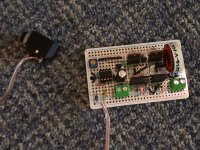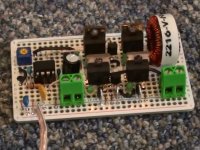This is my first foray into class D amplifiers. It is an implementation of Dimitrov's ATTiny based design which can be found here. I modified the code a bit to remove a DC offset and programmed it with the Arduino IDE.
My circuit has a high pitched noise problem, but otherwise seemed to do a decent job. I just thought someone might be interested. Although, I am certain you are all familiar with it already.
My goal was a small amplifier for my bass guitar. This does not have enough gain to take the raw signal and send it to the speaker. I'm working on a different circuit that uses a TPA3125 and includes a pre-amp.
My circuit has a high pitched noise problem, but otherwise seemed to do a decent job. I just thought someone might be interested. Although, I am certain you are all familiar with it already.
My goal was a small amplifier for my bass guitar. This does not have enough gain to take the raw signal and send it to the speaker. I'm working on a different circuit that uses a TPA3125 and includes a pre-amp.
Code:
/*
Class D Amplifier ATTiny85 Controller Sketch
last updated 6-23-2014
*/
#include <avr/interrupt.h>
#include <avr/sleep.h>
#include <stdint.h>
#define DACP OCR1A
#define DACN OCR1B
// variable declarations
byte time;
unsigned int pos;
unsigned int neg;
unsigned int adc;
int val1 = 0;
int errorSum = 0;
void setup() {
// Disable global interrupts
cli();
// Configure ports
DDRB = B00010010;
PORTB = B11100100;
// Configure ADC
ADMUX = B11010011;
ADCSRA = B11000100;
// Power reduction
PRR = B00000110;
MCUCR = B00100000;
// Configure PWM
TCCR1 = B01100010;
GTCCR = B01100000;
TIMSK = B100;
PLLCSR = B110;
// Enable global interrupts
sei();
}
void loop() {
sleep_cpu();
}
ISR(TIMER1_OVF_vect) {
if(1 & ++time){
adc = ADC;
val1 = (adc >> 2) - 127 - (errorSum >> 10);
errorSum = errorSum + val1;
pos = 127 + val1;
neg = 128 - val1;
DACP = (pos & 255);
DACN = (neg & 255);
} else {
DACP = (pos & 255);
DACN = (neg & 255);
}
}Attachments
Last edited:
The ATTiny85 has plenty of processing grunt. I'm using an ATTiny25 (85 w/less flash) in this guy:
https://www.youtube.com/watch?v=SlrnY7rLIJ4
I'm reading 31.25KHz, 8-bit data from a SPI flash chip using the USI peripheral, doing a 4x linear interpolation up to 125KHz, and feeding the output timer with the upsampled signal. Including wake from sleep and interrupt overhead, I'm using ~50% of the available 8MHz cycles.
Main limitations of this chip as a class D amplifier are going to be the limited dynamic range and accuracy of the 10 bit ADC.
https://www.youtube.com/watch?v=SlrnY7rLIJ4
I'm reading 31.25KHz, 8-bit data from a SPI flash chip using the USI peripheral, doing a 4x linear interpolation up to 125KHz, and feeding the output timer with the upsampled signal. Including wake from sleep and interrupt overhead, I'm using ~50% of the available 8MHz cycles.
Main limitations of this chip as a class D amplifier are going to be the limited dynamic range and accuracy of the 10 bit ADC.
I wasn't too happy with my results and ended up using a dedicated chip. It could be my poor implementation and not the processor.
I was trying to duplicate this guy's results: https://youtu.be/CrAB9rIcakE
I was trying to duplicate this guy's results: https://youtu.be/CrAB9rIcakE
Last edited:
Caleb6543, thanks for posting! At some point I wondered, if the chip can be programmed successfully for this project with Arduino as ISP at all. Your code showed me, where I was wrong.
Also, burning correct fuses on ATtiny might help in your case.
My version of the amp is here. I was also planning to make a small amplifier for my acoustic-electric guitar.
I have one unexpected effect with the amp, however:
when the input gets too loud, the speakers get absolutely quiet (stuck in a certain position) and the sound doesn't return even after making input quiet again. I have to turn the amp off and on again to return the music in cases like that. I don't understand what's going on.
Did you try to use Dimitrov's code without changes? I find this line particularly interesting:My circuit has a high pitched noise problem, but otherwise seemed to do a decent job.
It gave me a clicking sound once every second or so. Removing (errorSum >> 10) helped. But I ended up using original Rouslan Dimitrov's code anyway (with slightest changes).Code:val1 = (adc >> 2) - 127 - (errorSum >> 10);
Also, burning correct fuses on ATtiny might help in your case.
My version of the amp is here. I was also planning to make a small amplifier for my acoustic-electric guitar.
I have one unexpected effect with the amp, however:
when the input gets too loud, the speakers get absolutely quiet (stuck in a certain position) and the sound doesn't return even after making input quiet again. I have to turn the amp off and on again to return the music in cases like that. I don't understand what's going on.
I plan to build this but with an external A / D converter.
Can you tell me what cheap A/D converter can I use?
Or what are the characteristics of an acceptable quality for music A/D converter?
How can I get a PWM with better resolution? With an IC not with synchronized PWMs
The PIC 30F2020 has 16 PWM fast but is 4 times more expensive.
Is It Correct What Do I Write? Attiny at 20MHz = 20 M Instructions per second
Pic30F2020 at 120MHz = 30 M Instructions per second
Can you tell me what cheap A/D converter can I use?
Or what are the characteristics of an acceptable quality for music A/D converter?
How can I get a PWM with better resolution? With an IC not with synchronized PWMs
The PIC 30F2020 has 16 PWM fast but is 4 times more expensive.
Is It Correct What Do I Write? Attiny at 20MHz = 20 M Instructions per second
Pic30F2020 at 120MHz = 30 M Instructions per second
This is my first foray into class D amplifiers. It is an implementation of Dimitrov's ATTiny based design which can be found here. I modified the code a bit to remove a DC offset and programmed it with the Arduino IDE.
My circuit has a high pitched noise problem, but otherwise seemed to do a decent job.
Please tell me, answer me:
-
I have made the amplifier with Attiny25 but it has great noise. The program was written by me and it is quite simple.
Attiny25 / 45/85 has several modes of sleep.
One of sleep mode is for reduce ADC noise
I do not know if I use this type of sleep, because I tried to set it up and I do not know if it was set correctly.
This may be the reason why he has such a big noise?
You could also post, please, the HEX file, because I have an Atmel programmer
- Status
- This old topic is closed. If you want to reopen this topic, contact a moderator using the "Report Post" button.
- Home
- Amplifiers
- Class D
- ATTiny85 based class D amplifier.

